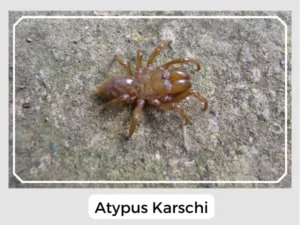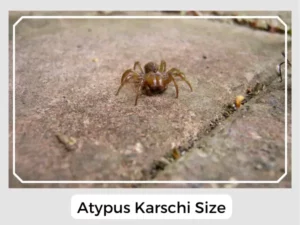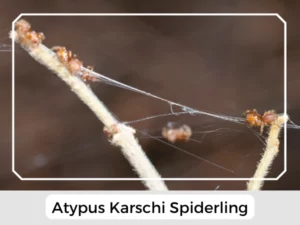The Atypus karschi spider is a special kind found in many places across Asia. It’s a part of the purse web spider family, which some people call atypical tarantulas. The spider’s name is a way to say “thank you” to a spider expert from Germany named Ferdinand Karsch.

Photo Credit: kuroyagi11

Photo Credit: kuroyagi11
A manifestation of maternal protection, the eggs of Atypus karschi are securely ensconced within the female’s webbing, safeguarded against predators and environmental adversities.
Upon hatching, these spiderlings showcase remarkable self-sufficiency. They have the unique capability to disperse aerially, leveraging the ballooning technique, which involves using silk threads to ride air currents.

Photo Credit: Rainer Breitling
The Atypus karschi is known for its distinctive webbing technique. It crafts a silken tube that is partly submerged underground and extends above the surface. This exposed section is cleverly camouflaged with leaf litter. Functioning as an ambush site, the spider waits patiently for prey to wander near, subsequently piercing through the silk to snatch its unsuspecting meal.
Yes, Atypus karschi Spiders have venom. They use it mainly to grab the bugs they eat. But for people, this venom isn’t too strong.
Atypus karschi Spiders can bite, but they’re mostly quiet spiders. They’ll only bite if they feel really cornered or threatened.
The Atypus karschi plays a pivotal role in its ecosystem. Their feeding habits help control populations of beetles, millipedes, snails, and woodlice, ensuring a balanced ecological interplay.
Natural Predator: While this spider is a formidable predator, it isn’t exempt from the circle of life. It often finds itself the target of birds, small mammals, and even other larger spiders. These predators keep the Atypus karschi population in check, preventing potential overpopulation.
Prey-Predator Dynamics: Specializing in ambush tactics, the Atypus karschi preys on carabid beetles, millipedes, snails, and woodlice. The spider’s unique web structure acts as both a home and a hunting ground. By maintaining this delicate balance of prey and predator, they ensure their ecosystem thrives, with neither their prey nor their predators becoming too dominant.
Relationship with Humans: Atypus karschi has mild venom. Bites, though rare, may cause slight redness. It’s best to approach with caution and respect.
| Lifespan | 8-10 years |
| Distribution | From the sprawling lands of China and Japan to the island nation of Taiwan, the Atypus karschi has marked its territory. |
| Habitat | Their habitats span fallow fields, dense forests, riparian woodlands, and even suburban bushes, showcasing their adaptability. |
| Common Predators | Birds, small mammals, and other spiders |
| Diet | Carabid beetles, millipedes, snails, and woodlice |
The Atypus karschi spider is a special kind found in many places across Asia. It’s a part of the purse web spider family, which some people call atypical tarantulas. The spider’s name is a way to say “thank you” to a spider expert from Germany named Ferdinand Karsch.

Photo Credit: kuroyagi11

Photo Credit: kuroyagi11
A manifestation of maternal protection, the eggs of Atypus karschi are securely ensconced within the female’s webbing, safeguarded against predators and environmental adversities.
Upon hatching, these spiderlings showcase remarkable self-sufficiency. They have the unique capability to disperse aerially, leveraging the ballooning technique, which involves using silk threads to ride air currents.

Photo Credit: Rainer Breitling
The Atypus karschi is known for its distinctive webbing technique. It crafts a silken tube that is partly submerged underground and extends above the surface. This exposed section is cleverly camouflaged with leaf litter. Functioning as an ambush site, the spider waits patiently for prey to wander near, subsequently piercing through the silk to snatch its unsuspecting meal.
Yes, Atypus karschi Spiders have venom. They use it mainly to grab the bugs they eat. But for people, this venom isn’t too strong.
Atypus karschi Spiders can bite, but they’re mostly quiet spiders. They’ll only bite if they feel really cornered or threatened.
The Atypus karschi plays a pivotal role in its ecosystem. Their feeding habits help control populations of beetles, millipedes, snails, and woodlice, ensuring a balanced ecological interplay.
Natural Predator: While this spider is a formidable predator, it isn’t exempt from the circle of life. It often finds itself the target of birds, small mammals, and even other larger spiders. These predators keep the Atypus karschi population in check, preventing potential overpopulation.
Prey-Predator Dynamics: Specializing in ambush tactics, the Atypus karschi preys on carabid beetles, millipedes, snails, and woodlice. The spider’s unique web structure acts as both a home and a hunting ground. By maintaining this delicate balance of prey and predator, they ensure their ecosystem thrives, with neither their prey nor their predators becoming too dominant.
Relationship with Humans: Atypus karschi has mild venom. Bites, though rare, may cause slight redness. It’s best to approach with caution and respect.
| Lifespan | 8-10 years |
| Distribution | From the sprawling lands of China and Japan to the island nation of Taiwan, the Atypus karschi has marked its territory. |
| Habitat | Their habitats span fallow fields, dense forests, riparian woodlands, and even suburban bushes, showcasing their adaptability. |
| Common Predators | Birds, small mammals, and other spiders |
| Diet | Carabid beetles, millipedes, snails, and woodlice |